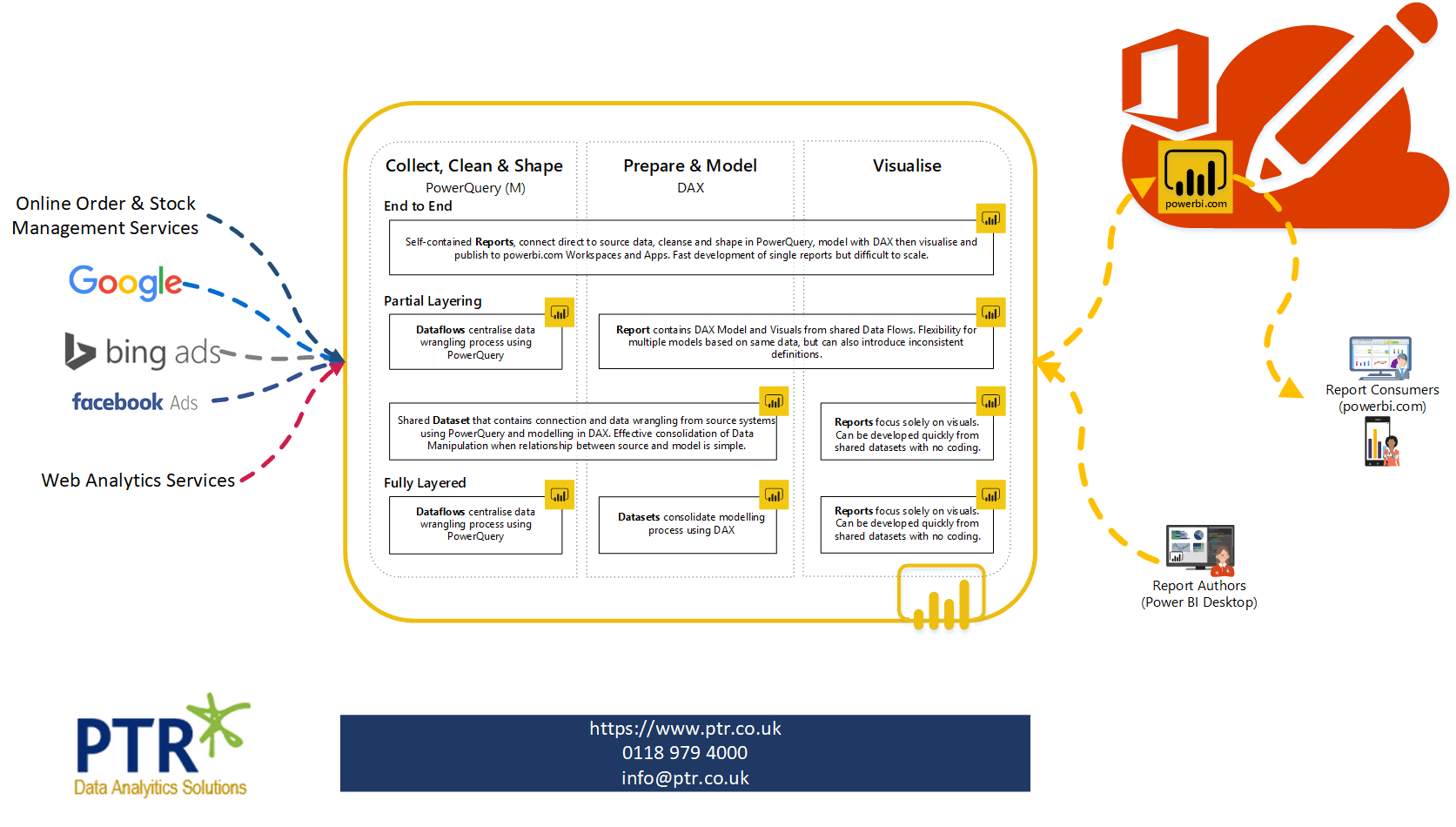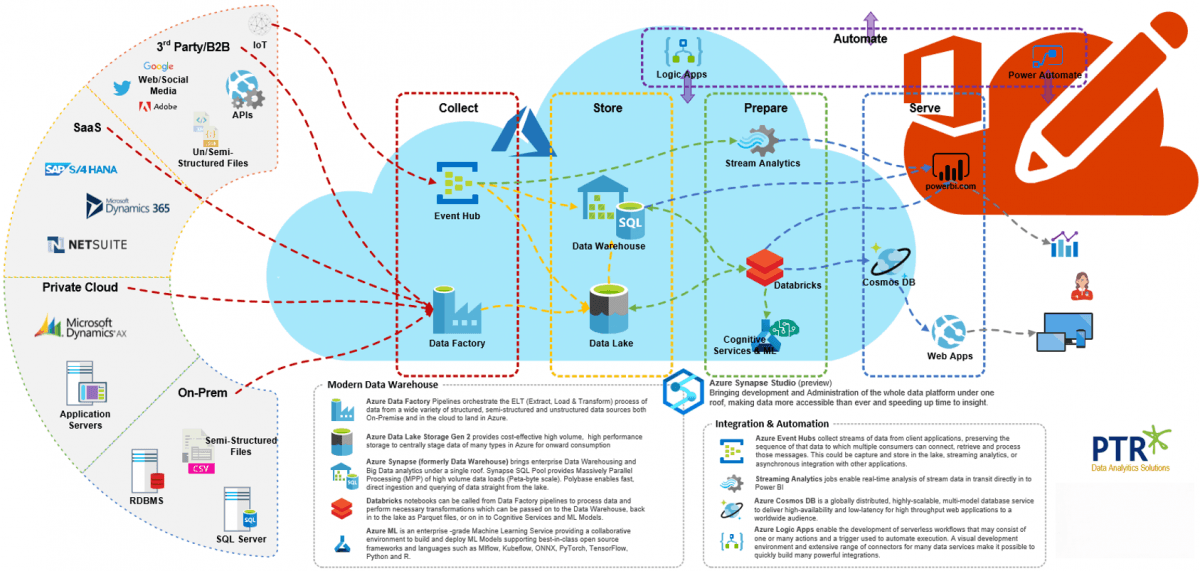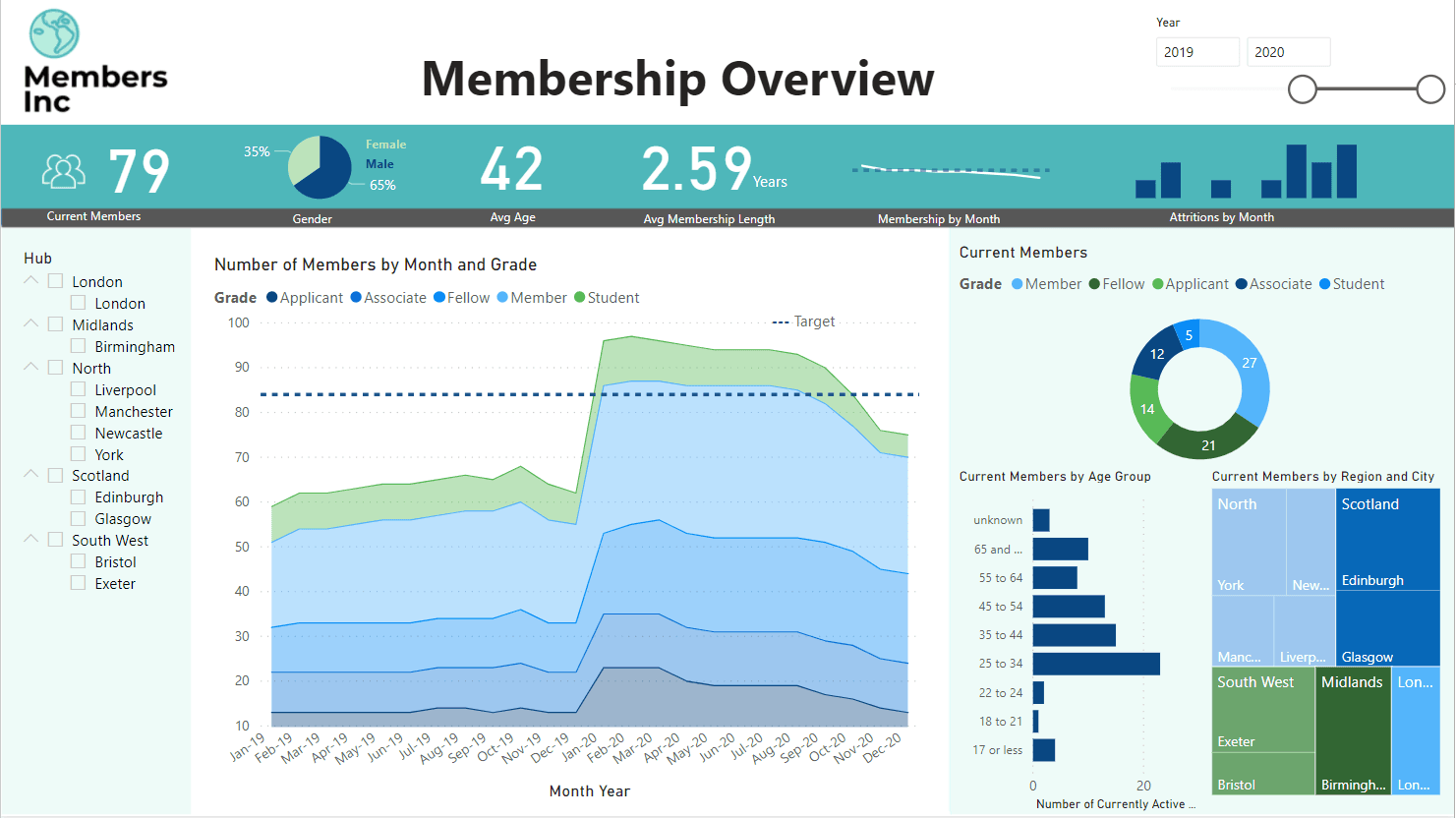Business Intelligence Solution Stages Consultancy Services
What is Business Intelligence

What Is Business Intelligence?
There are many definitions of Business Intelligence (BI). BI encompasses all things data, every stage of pulling data from live data sources, through to preparing that data so it is fit for analysis, storing the data in a secure and centrally accessible location, to relating the various data sets, building a business model incorporating all the business performance metrics that need to be measured and the hierarchies that will be used to drill down in to the data, through to designing engaging and powerful reports and dashboards.
Collect data from applications and sources
Cleanse and prepare data
Integrate data into a central location
Build a data warehouse
Build relationships between datasets
Define Key performance metrics and business measures
Build a business model
Develop static reports
Develop interactive dashboards
Uncover data stories and insights
Drive business decisions through data insights
Your current BI strategy might involve an Excel spreadsheet with pivot tables and charts, it might involve reporting tools such as SQL server SSRS, Cliq, Tableau straight into applications. You might have separate reporting tools and solutions for different applications and data sets. Or, you may have taken things a little further and developed a central data warehouse to house your business data in a single, related location.
So, Business Intelligence solutions may be fairly straight forward with limited data sources feeding into an Excel spreadsheet and dashboards built in pivot tables and pivot charts:

Or slightly more complex, but still relatively straight forward with limited data sources and a dashboard built in a separate reporting tool such as Power BI as shown in the following diagram:

The underlying business intelligence solution architecture and data platform may also be relatively straight forward implemented around a single platform as shown below:

Or might be far more complex, integrating data from many data sources and providing a central data repository suitable for traditional Business Intelligence reporting solutions as well as more modern Artificial Intelligence & Machine Learning solutions, as shown in the Azure based data platform solution in the next diagram:

The Business Intelligence Roadmap
We have already alluded to the Business Intelligence journey being different things to different organisations, so defining a single roadmap is an impossible task. But there are distinct stages that we can identify regardless of the number of data sources, location of data sources, reporting tools of choice.
Review of Data Estate & Data Strategy Development
Stakeholder and Business Partner Engagement & Needs Analysis
Data extraction
Data storage
Data Cleansing & Preparation
Data Shaping & Data Modelling
Report and Dashboard Design & Development
Report and Dashboard Publication
Data Strategy Development
Even for what you may feel is a fairly straight forward business intelligence requirement it is important to look at your long term goals with regards to your data estate and your future business intelligence and data analytics needs. Whatever you do now, you want to ensure that the business intelligence solution you roll out it is future proof and extensible, enabling you to introduce new data sources without re-engineering what has already been done, and to achieve new analytics requirements by adding to what you already have.
One potential issue of diving in to a quick business intelligence solution without previously developing a data strategy is that data governance issues can arise.
Have you thought about the security implications of delivering a business intelligence solution? Who will have access to the raw data sources that will drive your reports and dashboards? Where will the intermediate data be stored having been extracted from the live source? Where will reports and dashboards be accessible from? Who will see them? Do you need to restrict access to sensitive data?
Have you thought about who is in a position to validate any business logic and measures that are implemented for inclusion in reports and dashboards? Who is best qualified to ensure the integrity and consistency of your data to ensure accurate reporting?
Without an initial review of your full data estate it would be all too easy to select a data platform that is suitable for the initial limited data sets and data analytics requirements, but not so far down the line proves inadequate as additional data sets, reporting requirements and dashboard consumers are introduced.
You may find that the initial data platform selected does not support the connectivity to all future data sources that may need to be brought in to your business intelligence solution.
Have you thought about the initial and final data volumes and storage capacity that will be required?
What is your overall direction with regards to on-premise and cloud data strategy solutions?
What internal skills and resources do you have available?
What is your short and long term budget for your business intelligence solution?
Choosing a data platform and business intelligence architecture that meets your immediate, short and long term goals is vital for success. It can prove extremely time consuming and costly when work already undertaken has to be redone to accommodate new requirements because the initial platform cannot be adapted later stages.
This is not to say that you have to implement an all bells and whistles business intelligence solution from the outset. A well thought out data strategy will include milestones that map out a data journey for you, enabling you to start simply, affordably, quickly and to scale up over a timeline that suits your business priorities, budget and resource.
PTR's Business Intelligence consultancy service is available to take complete control of developing your data strategy for you, or we can support and mentor your team to assist them with building a robust data strategy for you.
Stake Holder & Business Partner Engagement
Business Intelligence solutions will either be driven by an IT function within your organisation or will come from within the business somewhere. Regardless of where the initial interest has come from a successful Business Intelligence solution will come from engaging the business and the key stakeholders at the beginning of the journey and keeping them involved throughout the whole data journey. The most common cause of a business intelligence project failing is lack of buy in from the business or a lack of understanding of what the business needs.
Before any solution can be designed a full Needs Analysis process will need to be carried out. This stage is challenging as it requires both a technical knowledge to understand thye capabilities of various platforms and tool sets, but also needs business knowledge and an understanding of what is required from a reporting and dashboard point of view.
From the business questions such as the following will need to be asked:
What are the key benefits to be delivered by reports and dashboards?
Who are the consumers of the reports and dashboards?
Where will the dashboards need to be accessed from?
What are the key business metrics to be measured?
How does the business drill down (slice and dice) into the business data?
What are the relationships between separate data sets?
Who owns the data and can make decisions about how data should be transformed to tidy it up?
Who defines the security polices and is responsible for data governance for the data to be consumed
From the technical representative questions such as the following will need to be asked:
What types of data sources do you have?
Is it possible to connect to the required data sources?
Is there a reliable way of relating separate data sources?
What is the anticipated volume and size of data to be included in the business intelligence solution?
How up to date do you require the data to be?
How much and what type of data cleansing and transformation will be required?
Do you have a cloud data strategy?
Do you have preferred vendor platforms such as AWS or Azure?
These are not exhaustive lists of questions and every client requirement is unique requiring a tailored approach each time, but engaging the business, carrying out a thorough needs analysis and gaining a full understanding of what the business wants to get from a business intelligence solution as a whole, short term and long term, is imperative.
Our team of business intelligence consultants are here to help you with this process. We pride ourselves on combining first rate technical skills with an ability to communicate complex ideas, technology, and data effectively, and working with clients to develop a deep understanding of their business processes and data objectives.
Data Gathering, Preparation & Integration
We work with clients pulling data from a myriad of data sources such as Sales, Supply Chain, Logistics, Financial, CRM and Audit systems to name but a few. The list of data sources that the many businesses and organisations we have worked with is endless and we have encountered most data challenges along the way, from initial connectivity issues, to poorly structured and poor quality data, to sheer vast volumes of data that need to be shifted. The gathering, preparation and integration of data is an incredibly complex stage, but vital if quality, trustworthy and consistent data is to be made available to reporting tools and authors.
We need to consider which tools will be appropriate for connecting to your data sources and transforming the data into its analytics ready form, and we must consider where is the most appropriate repository for storing your data.
Do you need a Data Lake?
Do you need a Data Warehouse?
Do you wish to host your data on-premise or in the cloud?
Where will data transformation take place? At source, in transit, at destination? ETL or ELT?
You may not know entirely what all of these options are, or which vendor offering might be the most suitable for you. PTR have been delivering Business Intelligence Consultancy for over 30 years guiding clients through the minefield of decisions that need to be made to select the most suitable data repositories and transformation tools.
Data Shaping & Modelling
The shaping and modelling stage of your business intelligence journey is where we start to build the relationships between your different datasets and implement the business logic that will feed reports and dashboards. How often have you seen multiple reports based on the same underlying data source, but different versions of the truth being presented due to multiple interpretations of key business terms such as Gross Profit or Stock Value, and varying calculations being used in different reports.
The business model will form your definitive central, "one-truth" source for business calculations and logic. The purpose of the model is to eliminate the need of any data preparation or formulae construction in the reporting environment. We define all of the business logic in one place to ensure that all reports and dashboards are based on a single, validated, consistent and quality dataset.
The model will present the language of the business, not technical language, and will be presented in such a way to make it easy to facilitate self-service business intelligence.
The model is where we will define all of your business logic, measures and performance metrics.
Reports & Dashboards
And finally we get to the pretty bit. Once we have well defined business model the process of designing reports and dashboards is relatively straight forward. The most important thing here is that we have a sound understanding of the business data, the purpose of the reports and dashboards, and the stories that are to be told from your business data.
We will start with some simple questions
Report or dashboard?
Detail or Summary?
Static or Interactive?
Who is the audience?
Why do they need it?
How will they use it?
Where will they view it from?
Historic or Predictive?
From here we can then start to choose the appropriate reporting tool and platform.
Business Intelligence is about more than simply reviewing historic performance such as sales reports, profit and loss reports, stock positions. It is about using our historic data to pre-empt outcomes and make better decisions
Business data can be used to tell a story of what is going behind the scenes.
Why is your profit up or down, or particular product out of stock?
Who is your best customer and what makes them your best customer?
How accurate are your forecasts? What are the strongest influencers to your sales?
Business data can also be used to predict future behaviours and drive informed business decisions.
What will our stock requirements be over the next few months?
What is our expected profit and loss?
How will a marketing campaign impact future sales?
Where should you focus your marketing activities?
What customer demographics should we focus on for maximum sales?
What resource will we need to fulfil predicted business?
The purpose and audience of a report or dashboard will drive the style of the visuals implemented. Focusing on the story telling and driving business decisions from your data the more interactive and visual the experience is the more useful it is likely to be for the audience.
Designing dashboards is an art. You don't want them too cluttered or too detailed, but equally you want to present all the key performance metrics in a single place and with clarity. You also want to enable the viewer to drill down into the data to answer questions they may have such as which stores are pulling your sales figures down, or which products have contributed to a bumper month.
The reporting platform selected for your business intelligence solution must provide a good variety of visuals that can satisfy all of your dashboard needs. Here are a few examples.
The following dashboard includes a mix of score cards, charts, tree maps and slicers to present an overview of membership statistics.

We see a variety of dashboard examples below from revenue, project management, membership and weather data sets.
Building a Business Intelligence Solution - Where do you start?
Start by contacting PTR and we can take you through your options. We can assess your requirements and put together a per day or project based consultancy proposal to get you to where you need to be. It is vital that you see an early return on investment without committing to an extremely high budget and the best way to do that is to let us work with you to break your requirements down into manageable and affordable stages.
We are a big fan of Proof of Concepts (POC) where we will work with you to choose an initial Business intelligence requirement that can be used to test the water and gain stakeholder confidence. A POC can help you to:
Prove a chosen data platform architecture as fit for purpose
Educate and equip your team with the new skills they will need going forward
Carry out sizing and capacity planning to assess the full cost and budget implications
Provide a relatively quick set of results to demonstrate the potential Return on Investment and benefits of a strong Data Strategy
Following a successful POC the full data analytics and business intelligence roadmap can be planned. By looking at the long term goals we can pull out the key business processes that need to be brought in to the data analytics solution, and in line with the data strategy can build the roadmap and timeline to start the journey.
It will be a journey, and the direction may from time to time change direction as business priorities change, but with a strong data Strategy and a well thought out roadmap these priority changes can easily be accommodated.
Whatever your Data Source challenge our Data Analytics Consultancy and Data Strategy Consultancy teams are here to help you. Call us on 0118 979 4000 or email us at info@ptr.co.uk for further information.
About PTR
PTR have held Microsoft accreditation since 2005, currently holding Gold Partner Status for Data Platform and Data Analytics. We have been working with clients on Data Strategy, Analytics and Business Intelligence solutions for over 30 years across a wide range of platforms and vendor solutions. We pride ourselves on combining first rate technical skills with an ability to communicate complex ideas, technology, and data effectively, and working with clients to develop a deep understanding of their business processes and data objectives.
Other related documents:
Data Analytics Consultancy - Data Source Challenges
Membership Engagement Analytics Solution
Frequently Asked Questions
Couldn’t find the answer you were looking for? Feel free to reach out to us! Our team of experts is here to help.
Contact Us